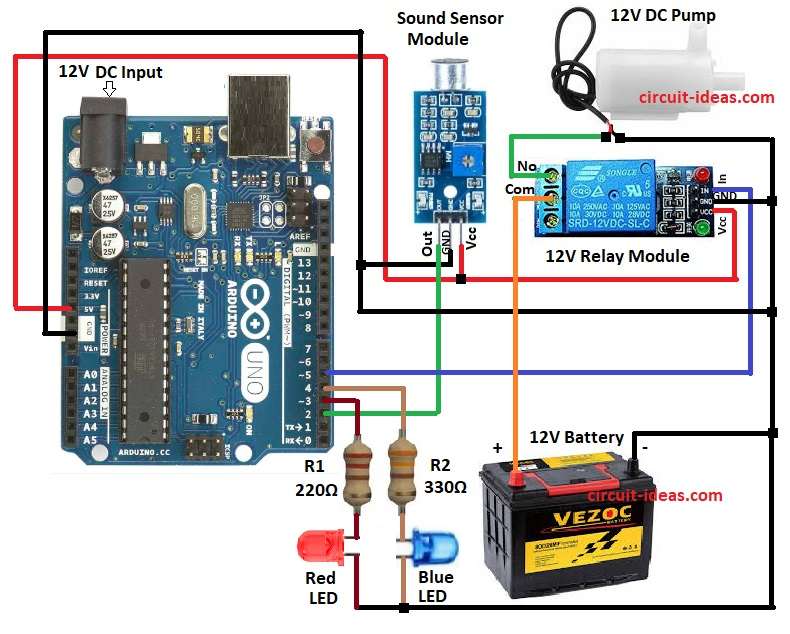Dancing Water Fountain Circuit with Arduino is small project where water moves like dance when music is played.
Sound sensor listen music beat and Arduino controls the motor pump.
Pump push water up and down in rhythm of sound.
With some LED light it look very beautiful like mini musical fountain at home.
Circuit is with easy parts, easy code but very fun to make and show our friends.
Circuit Coding:
int soundSensor = 2;
int ledRed = 3;
int ledBlue = 4;
int relayPin = 5;
int sensorValue = 0;
void setup() {
pinMode(soundSensor, INPUT);
pinMode(ledRed, OUTPUT);
pinMode(ledBlue, OUTPUT);
pinMode(relayPin, OUTPUT);
}
void loop() {
sensorValue = digitalRead(soundSensor);
if(sensorValue == HIGH) {
digitalWrite(ledRed, HIGH);
digitalWrite(ledBlue, HIGH);
digitalWrite(relayPin, HIGH);
} else {
digitalWrite(ledRed, LOW);
digitalWrite(ledBlue, LOW);
digitalWrite(relayPin, LOW);
}
}Code Explanation:
- Arduino uses sound sensor as input.
- LED and relay are output.
- Setup function tell which pin is input and which is output.
- Loop function run again and again.
- Arduino reads sensor value.
- If sound is high then Arduino make LED ON and relay ON.
- Relay ON means pump starts.
- If sound is low then Arduino make LED OFF and relay OFF.
- Relay OFF means pump stops.
- This repeat fast with music.
- Water moves like dance.
Circuit Working:

Parts List:
| Component | Specification | Quantity |
|---|---|---|
| Resistors | 220Ω, 330Ω 1/4 watts | 1 each |
| Semiconductors | Arduino Uno | 1 |
| Sound Sensor Module | 1 | |
| 12V Relay Module | 1 | |
| 12V DC Pump | 1 | |
| 5V Mini Pump (fountain) | 1 | |
| Red LED | 1 | |
| Blue LED | 1 | |
| Any Container | 1 | |
| 12V Battery | 1 |
The main parts of this circuit are:
Arduino Nano works as brain of the project
Sound Sensor Module which detects the sound or music beats
Relay Module which controls the 12V DC water pump
12V DC Water Pump, pumps water when music is detected
12V battery terminal goes direct to Pump terminal and also to Arduino GND
Resistors R1 and R2 are the protector for LEDs and Arduino.
LEDs show the status visually
The sound sensor gives signal to Arduino when sound crosses a set level.
Arduino checks this signal and sends output to the relay module.
The relay turns the pump ON or OFF depending on music beat.
LEDs are also connected to show the effect along with water.
Circuit works as follows:
Sound sensor detects sound level.
If sound is more than the set threshold then Arduino sends HIGH signal to relay.
Relay connects pump with 12V supply and water flows.
When sound is low then Arduino sends LOW signal and relay cuts pump OFF and water stops.
LEDs blink with the output so we can see the rhythm of dancing water fountain.
Formulas:
Relay module coil works at 5V from Arduino, while pump needs 12V.
Relay acts as isolation.
Pump current = P/V
If pump power = 12W and current = 12W / 12V = 1A.
So relay must handle at least 1A current at 12V DC.
Sound sensor sensitivity is set by onboard potentiometer.
It changes the voltage threshold for OUT pin.
How to Build:
To build a Dancing Water Fountain Circuit with Arduino follow the below steps:
- Gather all the parts as shown in circuit diagram
- Sound Sensor VCC connects to Arduino 5V
- Sound Sensor GND connects to Arduino GND
- Sound Sensor OUT connects to Arduino D2
- Red LED connects to Arduino D3 through resistor R1
- Blue LED connects to Arduino D4 through resistor R2
- Relay IN pin connects to Arduino D5
- Relay VCC connects to Arduino 5V
- Relay GND connects to Arduino GND
- 12V positive supply battery connects to Relay COM pin
- Relay NO pin connects to Pump positive (+)
- Pump negative (–) connects direct to 12V battery negative (–)
Conclusion:
This project for Dancing Water Fountain Circuit with Arduino shows how to make a low cost musical water fountain using Arduino.
The sound sensor detects beats, Arduino processes signal, relay drives the pump and water dances with music.
It is easy to make, fun to watch and can be used in school projects or hobby experiments.
References:
Design and construction of dancing fountains controlled by pic16f877a
Leave a Reply